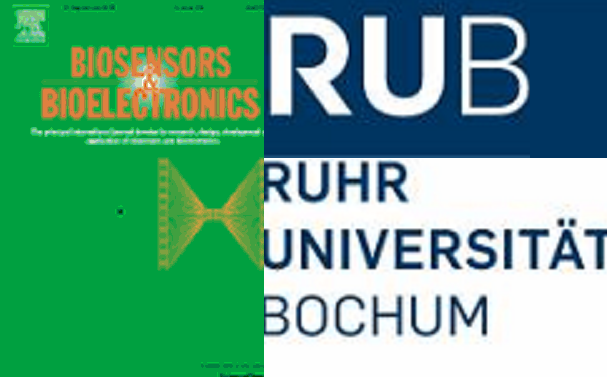Purchase/view the full paper HERE.
Bioelectrocatalytic and electrochemical cascade for phosphate sensing with up to 6 electrons per analyte molecule.
Gabriel Kopiec, Karolina Starzec, Jolanta Kochana, Troy P.Kinnunen-Skidmore, Wolfgang Schuhmann, Wilbur H. Campbell, Adrian Ruff, Nicolas Plumeré.
Highlights
•Second generation electrochemical phosphate biosensor.
•Bioelectrocatalytic-electrochemical cascade bypasses O2 interferences.
•Phosphate quantification is possible in complex sample matrices.
•Practical point-of-use phosphate sensing even in the hands of non-trained users.
Abstract
Despite the availability of numerous electroanalytical methods for phosphate quantification, practical implementation in point-of-use sensing remains virtually nonexistent because of interferences from sample matrices or from atmospheric O2. In this work, phosphate determination is achieved by the purine nucleoside phosphorylase (PNP) catalyzed reaction of inosine and phosphate to produce hypoxanthine which is subsequently oxidized by xanthine oxidase (XOx), first to xanthine and then to uric acid. Both PNP and XOx are integrated in a redox active Os-complex modified polymer, which not only acts as supporting matrix for the bienzymatic system but also shuttles electrons from the hypoxanthine oxidation reaction to the electrode. The bienzymatic cascade in this second generation phosphate biosensor selectively delivers four electrons for each phosphate molecule present. We introduced an additional electrochemical process involving uric acid oxidation at the underlying electrode. This further enhances the anodic current (signal amplification) by two additional electrons per analyte molecule which mitigates the influence of electrochemical interferences from the sample matrix. Moreover, while the XOx catalyzed reaction is sensitive to O2, the uric acid production and therefore the delivery of electrons through the subsequent electrochemical process are independent of the presence of O2. Consequently, the electrochemical process counterbalances the O2 interferences, especially at low phosphate concentrations. Importantly, the electrochemical uric acid oxidation specifically reports on phosphate concentration since it originates from the product of the bienzymatic reactions. These advantageous properties make this bioelectrochemical-electrochemical cascade particularly promising for point-of-use phosphate measurements.
Contributing organizations:
Center for Electrochemical Sciences (CES), Ruhr-Universität Bochum, D-44780 Bochum, Germany
Department of Analytical Chemistry, Faculty of Chemistry, Jagiellonian University, 30-060 Krakow, Poland
The Nitrate Elimination Co., Inc. (NECi), Lake Linden, MI 49945, United States
Analytical Chemistry - Center for Electrochemical Sciences (CES), Ruhr-Universität Bochum, D-44780 Bochum, Germany




